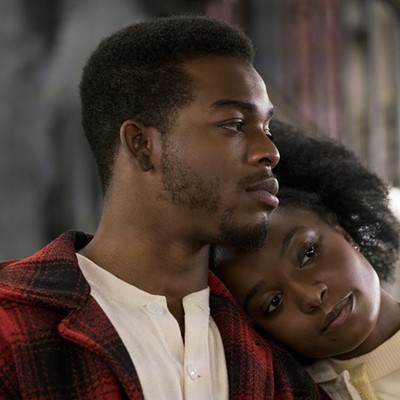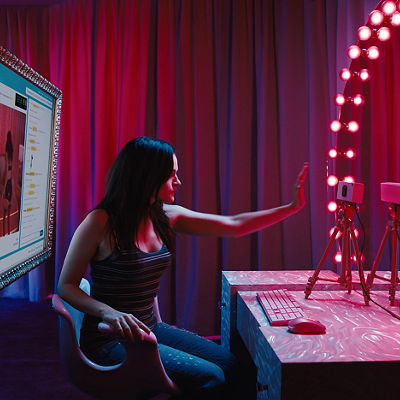It's nearly impossible to persuade the average American citizen, especially if he's a straight man, that haute couture has a reason to exist. The phrase isn't just a catchall for "really expensive clothes," as it's commonly misunderstood, but a specific term for clothes made entirely by hand, for a specific customer — something like a bespoke suit, though the workmanship and materials can be even more intricate and fanciful. A gown from one of the few remaining established couture houses can cost more than a studio in the West Village — and we're talking about the purchase price, not the monthly rent. The first thing any seemingly sensible person would say is, "For a dress? What a waste!"
But Frédéric Tcheng's marvelous documentary Dior and I could change your mind, or at least it should. In spring 2012, Belgian-born designer Raf Simons became the artistic director of one of the most revered couture establishments, the House of Dior. Christian Dior founded the house in Paris in 1946, and his postwar "New Look," a silhouette defined by a tightly constricted waist and extremely long, full skirts, radically shifted the direction of mid-twentieth-century fashion. Monsieur Dior was at the helm for only ten years — he died in 1957 — and his successors at the company include Yves Saint Laurent and the extraordinarily gifted, if truly messed-up, John Galliano, who was ousted in 2011 after a drunken, anti-Semitic tirade that deeply embarrassed the house. Though Galliano's name isn't even whispered in Dior and I, Simons, who'd previously worked for the far less frilly company Jil Sander, essentially had two big jobs to do: to re-polish the perception of an august and beloved French institution, and to somehow fit his own sturdy Belgian feet into the pristine prints left by one of the brilliant designers of the last century.
No wonder he freaks out in Dior and I, which chronicles the creation of his first couture collection for the house — one he had only six weeks to complete, rather than the usual six months. I'll give away the ending: The show was a triumph. But even knowing that, to watch Dior and I is to see the iceberg of potential disaster looming every second. In an early scene a clearly nervous Simons introduces himself to his staff of managers and assistants, many of whom are chic, scary Parisian women with brusque manners. But the people he really has to fear are those who actually put together the clothes in the atelier, or workroom. These highly skilled seamstresses and tailors have the means to make or break him. He's nervous, and they eye him just as warily. Many of these craftspeople, most of them women, have been working for Dior for 40 years or more. Does Simons really understand and respect their craft? And, perhaps more importantly, does he have the kind of vision that will ensure the success, and thus the survival, of the house that provides their livelihood?
Dior and I is a great fashion movie, but it's also a superb picture about the art of management, applicable to any field. Tcheng (the co-producer and editor of another terrific documentary about couture, the 2008 Valentino: The Last Emperor) coaxes out the personality of each player in this little drama with clarity and humor. Simons's own sartorial sense underscores that he's a foreigner in a strange land: His summer uniform includes shorts, socks, and sturdy shoes, a getup that doesn't exactly scream "Paris." Simons is demanding, but perhaps a little too authoritarian. Because his manner with his workers can be gruff, he's lucky to have a charming right-hand man in Pieter Mulier, who wins them over instantly. (It helps that Mulier's French, unlike Simons's, is excellent.) We see, only briefly, Simons's bigwig boss Bernard Arnault, the beady-eyed multizillionaire CEO of Dior's gigantosaurus parent company, LVMH — that two seconds of screentime is enough.
But the real stars of Dior and I are the petites mains: The traditional name for the team of embroiderers, seamstresses, and tailors in a couture house translates to "small hands," but it might be more accurate to think of them as mighty, instead, given their ability to turn thread and cloth into a fantasy you can actually touch.
We meet easygoing Florence Chehet, who manages the atelier flou — in other words, she supervises the creation of fancy dresses, confections that might involve thousands of tiny navy-blue lace leaves, painstakingly layered by hand, or that might require the development of a special, hard-to-perfect fabric. (Simons's big dream for the show is to use a complex and nearly obsolete printing technique to re-create the paintings of Sterling Ruby on cloth.) Middle-aged Florence is businesslike and girlish at once — she flirts openly with the younger Mulier, and he with her, in a happy workplace pas de deux that has no regard for age differences or sexual orientation. ("It is what it is," she says lightly. "It's nature.")
More tense and somber is Monique Bailly, who manages the atelier tailleur — she supervises the tailoring, and she worries a lot, popping candy into her mouth when the stress becomes nearly unbearable. Monique can be prickly, but it's easy to see her anxiety stems from a devotion to perfectionism, perhaps mixed with a little shyness. "She has magic in her hands," Mulier says, and you can see it in the way she surveys the curve of a jacket, and in her ability to communicate with Simons — who knows his tailoring — in a shorthand language you'd think only Martians could comprehend.
The finale is the show itself, one that has come together against all odds. Until very recently (it's shocking how recently), these magnificent garments were just flat pieces of cloth laid out on a table. Now they're lustrous coats that resemble paintings in motion, short ballerina tops perched daintily atop narrow pants like flower stems, gowns whose skirts hum with the quiet shimmer of little glass beads, each secured by hand. Simons, overcome by the feat he and his proud staff have pulled off, greets his elderly parents, who have come to share his big moment. His face, previously that of an endearingly cranky cartoon character, now looks as if he has witnessed a miracle, and maybe he has. Most of us can't afford couture clothes, but we can look on with wonder twice a year, when the couture shows are held in Paris, and believe in this very specific, specialized beauty made by human hands. To have the money to buy is unimaginable. But to believe costs nothing.





